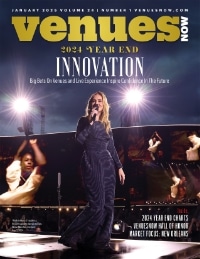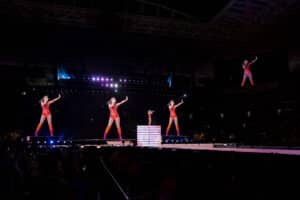A look at the 1923 Club, which will make its USC football debut Aug. 31. (Courtesy USC)
Spectacular views prompted development of 1923 Club
The hidden gem of the $315 million renovation of United Airlines Field at the Los Angeles Memorial Coliseum, according to project officials, is the 1923 Club, the expansive rooftop deck constructed at the historic stadium’s highest level.
The coliseum has been home to the University of Southern California football team since 1923, and the rooftop name reflects that heritage. The general admission space sits atop the Scholarship Club Tower, the new seven-story premium seat structure on the south sideline.
To gain access to the 1923 Club, patrons must be a donor to the Trojan Athletic Club. Individuals pay a $2,500 membership fee that covers two people. The fee does not include game tickets. USC athletic department officials, in conjunction with Legends, the school’s sales agency, restricted membership to 250 for the 500-capacity space.
“We were able to offer the club to four of the six (donor) levels before it sold out with quite a large waiting list,” said Steve Lopes, senior associate athletic director.

There’s plenty to take in from the new 1923 Club at United Airlines Field at the Los Angeles Memorial Coliseum. (Courtesy USC)
The 1923 Club came together late in the project after officials discovered the rooftop’s spectacular views of downtown Los Angeles and the Pacific Ocean, Catalina Island and San Gabriel Mountains.
“The views are incredible, so we put some resources and funding into it and upgraded the finishes,” Lopes said.
The design is similar to the Sunset Deck at Banc of California Stadium, Los Angeles FC’s Major League Soccer facility next door to the coliseum that opened in 2018. Levi’s Stadium also served as a model, said Don Barnum, a principal with renovation designer DLR Group and its global sports leader.
The difference is the 1923 Club is a much larger space sitting atop the 235,000-square-foot tower.
Views to the field are limited to open seating along the rail fronting the outdoor space. It’s mostly lounge seating supported by multiple bars, televisions, concession stands and restrooms.
The Los Angeles Rams, entering their fourth and final season as a temporary tenant before moving into their new $5.2 billion stadium in 2020, plan to use the 1923 Club for corporate hospitality, said Joe Furin, the stadium’s general manager. The Rams will play at the coliseum for the first time since last season in a preseason game Saturday.
All told, USC has about 100 club seats and one Founders Suite remaining to sell, numbers that remain largely unchanged since the ceremonial groundbreaking in January 2018. Lopes is confident everything will sell out over the next few weeks as prospective buyers tour the finished products. USC’s first home game is Aug. 31 against Fresno State.
The unsold club seats are near the goal lines. They carry a one-time gift of $25,000 per seat plus $20,000 a year for up to eight seats.
The 20 Founders Suites distributed over two levels are all seven-figure deals tied to 20-year terms.
The 22 traditional suites on the sixth level, one floor below the press box, have been sold out for more than a year, as well as the 24 loge boxes.
The seating bowl itself has all new seats with more legroom and twice as many aisles. There are now 18 seats across a section compared with 38 seats under the old configuration, which makes it much easier for fans to maneuver through the bowl. Total seating is 77,500, down from 92,000.
“We did pretty well,” Lopes said. “In one building, we have five different types of premium seating. We don’t have a lot of any one thing, but a good mix. We wanted to give people an opportunity to be able to view the game as they wanted to view it.”
“We’ve got something for everyone,” he said, “including those people that just want to hang out and socialize and watch the game from time to time up on the roof, which is more and more what the young folks want.”








